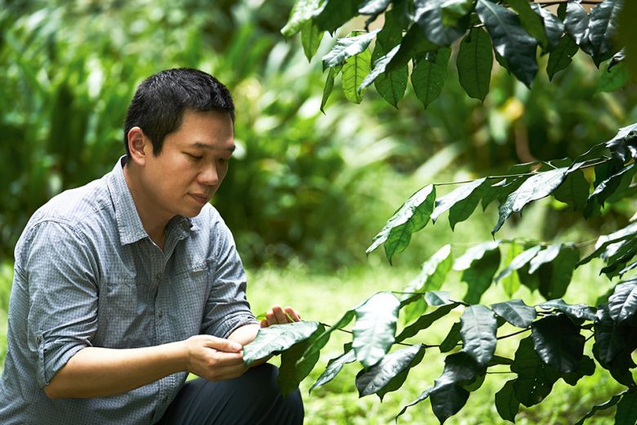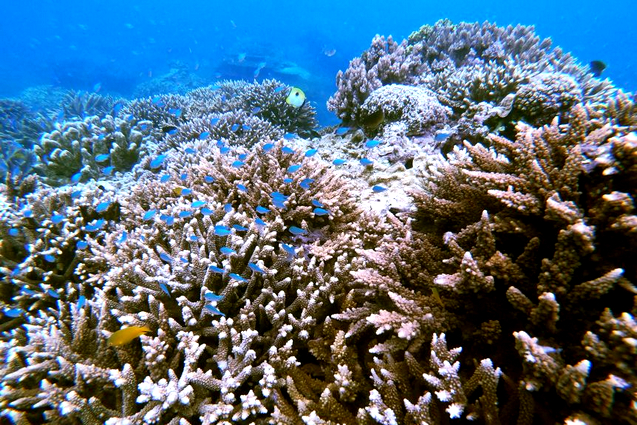Straits Times - Tee Hun Ching
After 16 years abroad, prominent conservation scientist Koh Lian Pin has returned to tap new areas for growth, to help Singapore emerge from the Covid-19 crisis stronger, and greener

|
|
Prominent conservation scientist Professor Koh Lian Pin says “we
can aspire to emerge from this Covid-19 crisis stronger — and
greener”. PHOTO: NICKY LOH
|
Professor Koh Lian Pin, however, was receiving some troubling reports: Desperate, people across Asia and South America were resorting to illegal logging and wildlife poaching as the pandemic pummelled economies worldwide. Their actions put endangered species such as Sumatran tigers, rhinos and orangutans under even greater threat.
“Although there were positive stories about cleaner air and wildlife reclaiming their space, the Covid-19 situation has also resulted in higher impacts on natural ecosystems,” said Prof Koh, who helms the new Centre for Nature-based Climate Solutions at the National University of Singapore (NUS).
The prominent conservation scientist returned to Singapore in March under a National Research Foundation scheme, after spending 16 years working in institutions across Australia, Switzerland and the United States.
Prof Koh, 44, is well-attuned to the perennial tussle between protecting nature and safeguarding livelihoods.
After all, his job includes weighing the environmental costs of economic growth in crafting approaches that inform Singapore’s policies and decisions on climate challenges.
The worst public health crisis in a century has unleashed a global economic bloodbath. It is hard for people to worry about the planet’s health when they are fretting over their next paycheck.
But while the exact origin of the novel coronavirus remains a mystery, Prof Koh said, “There is little doubt that an important measure to prevent future pandemics is to avoid further destruction and degradation of our natural ecosystems and to reduce our exposure to wild sources and vectors of zoonotic diseases.”
Unsustainable farming, mining and forestry practices often damage and encroach upon nature, driving wildlife into contact with people.
Blueprint for going green
Increasingly, countries are aware that charting a green path forward is critical to their recovery — and the world’s survival.
A New Nature Economy report released in January by the World Economic Forum noted that US$44 trillion (S$55.3 trillion) of economic value generation — or more than half of the world’s total gross domestic product — is moderately or highly dependent on nature.
For instance, factors like a stable climate, clean water and pollination are crucial to the global agriculture sector worth US$2.5 trillion. So prioritising nature’s assets is vital to countries’ economic welfare.
The pandemic, said a follow-up report in July, is a wake-up call for the world to “change the way we eat, live, grow, build and power our lives to achieve a carbon-neutral, ‘nature-positive’ economy and halt biodiversity loss by 2030”.
“Business as usual,” it warned, “is no longer an option.”

|
|
Prof Koh, who is part of the Emerging Stronger Taskforce, is
helping to draw up the blueprint for Singapore’s green aspirations
and economic recovery. PHOTO: NICKY LOH
|
Other such coalitions — called Alliances for Action — have been set up to do the same for areas including robotics, e-commerce and education technology.
The focus on sustainability, as well as environmental, social and governance (ESG) standards, is set to grow in the post-Covid reality. More investors are using ESG criteria to evaluate potential investments, which the Sustainability Alliance sees as a chance for Singapore to develop related solutions and services to meet its own needs as well as global demand.
Prof Koh, a well-known researcher in the field of sustainability and environmental science, is helping to draw up the blueprint for the city-state’s green aspirations. He is part of the Emerging Stronger Taskforce, which was set up in May to guide the country's economic recovery from the pandemic.

|
|
Prof Koh on a recce field trip to the Flinders Ranges National
Park in South Australia in 2017.
PHOTO: KOH LIAN PIN |
Such cost-effective land management strategies, says Prof Koh, can save up to 11 billion tonnes of CO2 a year globally. This works out to nearly 80 per cent of China’s carbon emissions in 2019, which were estimated to be 13.9 billion tonnes.
Singapore as a carbon hubReducing the concentration of CO2 — the main greenhouse gas driving global warming — in the atmosphere would help mitigate the effects of climate change and build climate resilience.
With the growing concern over climate change and sustainability, Singapore is also looking to position itself as a carbon services hub in Asia to generate new jobs and economic value.
There is little doubt that an important measure to prevent future pandemics is to avoid further destruction of our natural ecosystems.Prof Koh Lian Pin, 44, Professor of Conservation Science, Technology and Policy in the Department of Biological Sciences, NUS Faculty of Science
These include legal, financial, engineering, research and consultancy services related to the market for carbon credits as more countries and companies seek to offset their carbon footprint.
The Sustainability Alliance has been market-testing various concepts, such as a one-stop solution for companies to measure, mitigate and offset their carbon emissions.
Prof Koh and his team are providing valuable scientific input to this push — nature-based solutions form a vital supply of carbon credits and are fast gaining traction in international policy and business.
They are currently working on several “priority policy-relevant research projects”, which include technology-based mapping, monitoring and verification of the climate mitigation potential and financial returns of such solutions across the region.
Protecting blue carbon ecosystemsFor example, they are studying the potential for cities around the world, including Singapore, to contribute to carbon sequestration and biodiversity conservation by reforesting pockets of their urban landscape without compromising economic opportunities, housing and other social needs.
The centre is also beefing up its skills, manpower and other resources in areas such as forest restoration and blue carbon, or carbon dioxide captured by the world's oceans and coastal ecosystems.
By early next year, Prof Koh hopes to expand the centre’s headcount from the current 35 researchers and students to 50.
He was last based in Seattle as the vice-president of science partnerships and innovation at Conservation International, a non-profit environmental group.
It is clear from his impressive CV why Singapore has worked to woo him back under the Returning Singaporean Scientists scheme.
In between publishing journal articles, speaking at global conferences and giving interviews to international press, he also found time to set up ConservationDrones.org. The non-profit organisation seeks to build and share low-cost drone technology with conservation scientists for use in their research work and to raise public awareness of challenges in their fields.
A bumpy homecomingAfter an illustrious career overseas, Prof Koh assumed the post of Professor of Conservation Science, Technology and Policy in the Department of Biological Sciences at the NUS Faculty of Science in April.
His job titles might all be a mouthful. But his motivation for coming home is straightforward: “My desire to make a long-lasting difference and impact to the conservation of our natural environment in Singapore and the region.”
His return in late March coincided with a spike in local Covid-19 cases. Seattle had been hit hard and early, so he and his homemaker wife were no strangers to strict safety measures or stay-home orders.
During Singapore’s circuit breaker, the couple, who live on campus with their two Ragdoll cats, simply adapted by “running around the block for exercise every morning”.
They had met as biology undergraduates at NUS, when he was “helping her with her crow research and she was helping me with my butterfly surveys”. Since the curbs eased, they have resumed their favourite weekend pursuit of going for long walks.

|
|
Prof Koh with his wife, Juanita Choo, and their furkids, Mia
(left) and Pickle.
PHOTO: KOH LIAN PIN |
What is harder to stomach, though, is the rampant use of plastic here. “We were shocked by the number of plastic bags used when we first went to the supermarket,” he recalled with a laugh.
Investing in people, planet and partnershipThe “planet or plastic” problem has no easy solution, just like the many ecological conundrums Prof Koh regularly faces. Balancing the competing priorities and trade-offs is always a challenge.
“For example, the need of some rural communities to maintain their traditional livelihoods or expand their agricultural lands may compete with climate strategies that protect or restore forests for carbon storage and sequestration,” he wrote in a May commentary for ThinkChina, an English-language e-magazine by Lianhe Zaobao.
The “triple bottom line” framework of people, planet and profit has been adopted by many socially-conscious decision-makers since the term was coined in 1994. As Singapore strives for a more sustainable economy and further decarbonisation, Prof Koh is aiming for another “p”: partnership.
He has been busy engaging stakeholders from the public and private sectors, educators and civil society to help turn the Little Red Dot into a green one.
His ultimate goal is to devise win-win solutions that are “scientifically sound, economically feasible and socially acceptable”.
“The best policies and solutions will not work unless there is buy-in from an informed public that understands the hard decisions and compromises that will have to be made, as well as the new opportunities that our society can aspire towards as we emerge from this crisis not just stronger but also greener,” he said.
Prof Koh is hoping for a recalibration of individual priorities too. “Perhaps we don’t need mountains of extravagant food, a vehicle for each family member and, in general, redundant stuff being produced and consumed that does not actually improve human well-being.”
Big changes, as they say, start with small steps.
Links- Green finance seen as key in Singapore's climate change fight
- Green finance among options Singapore needs to adopt to achieve climate and economic goals
- Renewables powering an employment boom
- Helping firms grow in climate-conscious world
- More community gardens, opportunities to participate in green initiatives for East Coast residents
- S'pore urged to aim to be R&D hub for alternative energy
- How 7 industry-led coalition groups are preparing for Singapore's post-Covid economy
- Can Singapore rebound from the Covid-19 crisis stronger and greener?





